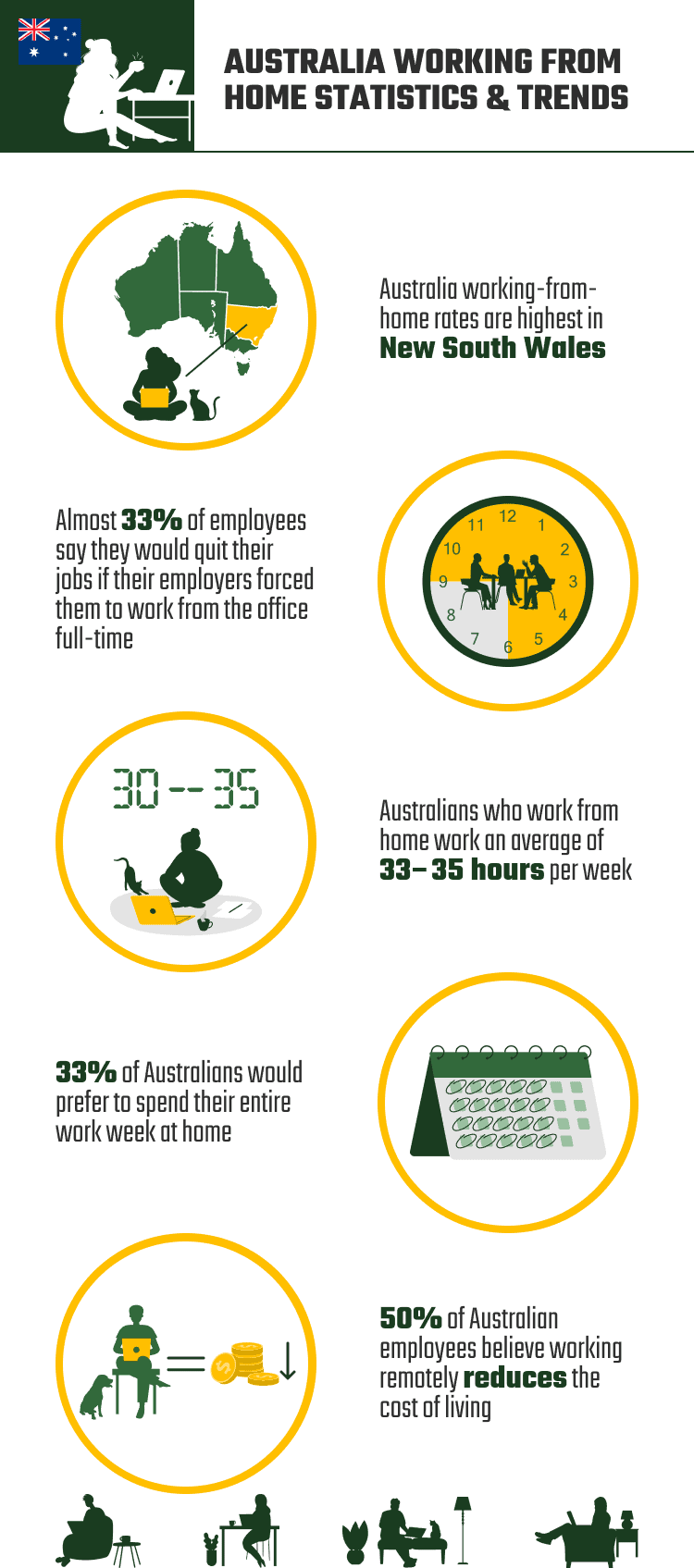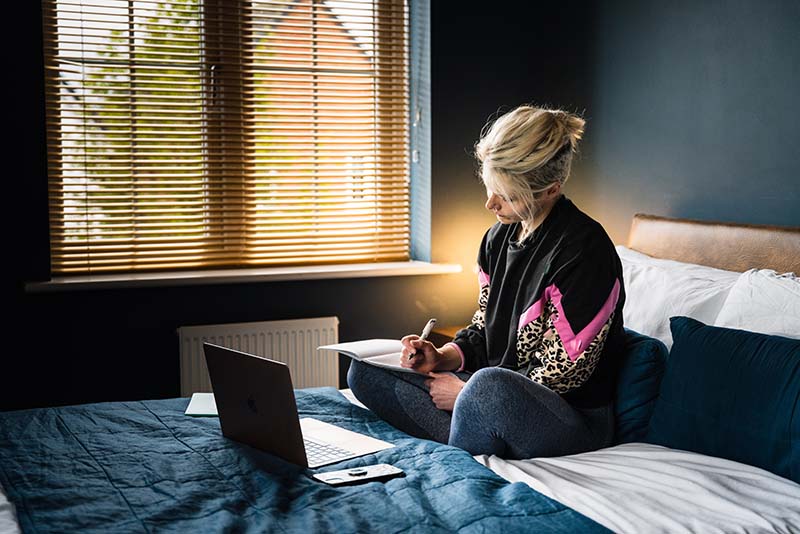15 Working from Home Statistics & Trends in Australia to Know in 2025
-
Pete Ortiz
- Last updated:

Note: This article’s statistics come from third-party sources and do not represent the opinions of this website.
Working from home is a growing workplace trend in Australia. What started as a short-term strategy when covid hit in 2020 has now become a common and desired working method. It has revealed the potential for remote and hybrid work within businesses by improving work production, creativity, and work-life balance.
In this article, we’ll look at some interesting working-from-home trends and statistics in Australia to help you decide if it’s a viable option for you or your company’s employees.
Click below to jump ahead:
The 15 Working from Home Statistics & Trends in Australia
- Working-from-home rates are highest in New South Wales.
- Over 86% of HR Professionals offer part-time work as a flexible practice.
- Almost one-third of employees say they would quit their jobs if their employers forced them to work from the office full-time.
- Australians who work from home work an average of 33–35 hours per week.
- One-third of Australians would prefer to spend their entire work week at home.
- Approximately 44% of Australians are doing hybrid work.
- According to a recent survey, 65% of workers reported that one of the challenges of remote working is a sense of disconnection among colleagues.
- One of the main reasons Australians work from home is because of flexible working arrangements.
- 50% of Australian employees believe working remotely reduces the cost of living.
- Hybrid working options can significantly increase the economic benefits of Australia, creating an average of about 42,500 full-time jobs by 2031.
- Since implementing hybrid working, the quality of work has improved, and many industries have benefited.
- Since implementing hybrid working, 52% of mining, energy, and resources companies and 50% of technology companies have increased their productivity.
- Among workers who are able to work from home, 62% show concern about contracting COVID-19 at work if going back to the office.
- Approximately 30% of Australians who work from home say they have a better work-life balance.
- The cost of commuting is the primary reason employees choose to work from Home.

Working from Home Trends
1. Working-from-home rates are highest in New South Wales.
(Statista)
In a survey conducted in September 2022, New South Wales represented the state with the highest rate of Australians working from home, spending an average of 2.53 days working from home.
New South Wales is Sydney’s most populous city, which could help account for it having the highest rate of employees working from home, especially with the pandemic being a catalyst for the trend.

2. Over 86% of HR Professionals offer part-time work as a flexible practice.
(Statista)
In a July 2022 survey of HR professionals in Australia, more than 86% of participants indicated that their company gives part-time work as a flexible working practice. Around 5% of participants said their company did not provide flexible working arrangements.
Working part-time between the office and home can allow for more flexibility. Flexibility between life and work can result in employees being more productive, which could contribute to the reason why most companies offer flexible options.
3. Almost one-third of employees say they would quit their jobs if their employers forced them to work from the office full-time.
(Statista)
Working from home is a growing trend in the workforce, and employees who have experienced the benefits, don’t want to lose them. While some people prefer the office environment, one-third of Australians say they would rather quit than return to the office, while 18% are still undecided.
The advantages and disadvantages of working from home will weigh differently for everyone. Still, with the benefits being so great that people are willing to leave their jobs to stay out of the office, it’s clear that working from home is a growing trend.
4. Australians who work from home work an average of 33–35 hours per week.
(Melbourne Institute)
The average work week is 31 hours for Australians, and Australians who work from home are clocking in an average of 33–35 hours per week. This figure is on par with working from an office, if not greater, indicating that the average employee is likely more productive when working from home.
This could be due to fewer distractions and perhaps flexibility that allows an employee to catch up with work or do extra work after typical working hours.

5. One-third of Australians would prefer to spend their entire work week at home.
(Melbourne Institute)
While some workplaces offer a hybrid working method, where some days are spent in the office and others are remote, one-third of Australians would prefer to have their whole work week at home. 82% currently work at least part of their workweek from home, and 89% want to continue hybrid working.
6. Approximately 44% of Australians are doing hybrid work.
(The Conversation)
Almost half of working Australians, 44%, are doing hybrid work, where work hours are split between the office and home. Hybrid variations include combining fixed and flexible days, such as one set day in the office and two days of the worker’s choice, as well as other specified arrangements. Before the pandemic, only 28% of Australian workers had the option of working remotely for any part of the week, so this method of work is a fast-growing trend.
7. According to a recent survey, 65% of workers reported that one of the challenges of remote working is a sense of disconnection among colleagues.
(AHRI)
There are pros and cons to any working arrangement, and for employees working from home, more than half of them, 65%, report feeling disconnected from their colleagues. While many available online platforms keep colleagues connected, the pandemic taught us all that physical interaction and face-to-face interaction are important in connecting with a relative, friend, or colleague.
Benefits of Working from Home
8. One of the main reasons Australians work from home is because of flexible working arrangements.
(Statista)
One of the main reasons Australians work from home is because of flexible working arrangements. In 2021, less than 5% of Australians regarded childcare or family considerations as the primary reason for working from home. Flexibility during working hours can be helpful for unforeseen situations, especially when an employee has children.
Life is full of surprises, and having the flexibility to deal with them without missing work or taking a full day’s worth of leave can reduce stress levels and increase productivity.

9. 50% of Australian employees believe working remotely reduces the cost of living.
(Statista)
In a survey conducted in Australia in June 2022, nearly half of the participants indicated that working from home is the better arrangement for lowering living expenses, while one-third of participants felt that working in an office was the best way to save money. Working from home can save money on gas for your car, train and taxi fare, and unnecessary expenses.
10. Hybrid working options can significantly increase the economic benefits of Australia, creating an average of about 42,500 full-time jobs by 2031.
(Ones Software)
Working from home is not only beneficial for employees and companies, but it can increase employment rates and create economic benefits for Australia. Hybrid work can bring 53,500 additional workers to the labor force in the future, and the workforce can provide significant economic benefits to Australia, increasing national GDP by $18.3 billion and creating an additional 42,500 full-time jobs by 2031.
11. Since implementing hybrid working, the quality of work has improved, and many industries have benefited.
(Ones Software)
Since incorporating hybrid work in the workforce, the work quality has improved, benefiting many industries. Technology and media account for 66% of all businesses, followed by banking, finance, and insurance (63%) and retail (29%).
12. Since implementing hybrid working, 52% of mining, energy, and resources companies and 50% of technology companies have increased their productivity.
(Ones Software)
Since incorporating hybrid working, 52% of mining, energy, and resources companies and 50% of technology companies have increased their productivity. Hybrid working can increase diversity, introduce new methods, and reach a wider range of creative employees.

 Reasons for Working from Home
Reasons for Working from Home
13. Among workers who are able to work from home, 62% show concern about contracting COVID-19 at work if going back to the office.
(Statista)
If an employee works in a small space shared with many other employees and perhaps has a weak immune system, the concerns about contracting the virus are a reasonable reason for wanting to work from home, where you can have more control over your health.
14. Approximately 30% of Australians who work from home say they have a better work-life balance.
(The Conversation)
Another common reason for working from home is that employees have a better work-life balance. This is especially true for employees with families and kids, where there is always something to take care of.
The reduction of time from commuting can add an extra hour or two to someone’s day, which allows them to run a quick errand or get to the gym. 27.4% said having more time to invest in their health and wellness was the most crucial benefit of having a better work-life balance.
15. The cost of commuting is the primary reason Employees Choose to Work from Home.
(Ones Software)
The cost of commuting is the primary reason why Australians do not want to work in an office. The average Australian commuter travels 33 kilometers in 54 minutes at an average cost of $20 per day. The average Australian spends $112 per week on commuting costs, which amounts to $4,924 per year when public holidays, annual leave, and sick leave are factored in. This includes gas but excludes toll roads, parking, and car insurance. Meanwhile, the average Australian spends $35 per week on public transportation.
Working from home can save a significant amount of money by reducing traveling.
Frequently Asked Questions About Working From Home in Australia
What Are the Benefits of Working From Home?
Working from home can provide many benefits for workers, but the benefits can vary from person to person.
Working from home gives you extra control over your personal life and work. The time to run errands, pick up kids from school, recover from a headache, take a morning run, and prepare a healthy lunch, to name a few, is more available.
Working from home also doesn’t necessarily mean your home. With the opportunity to be remote, you can use restaurants and cafes or shared office spaces if you need to be in a new location for a meeting, school event, or even a change of scenery. Remote work also allows you to travel and change your location if you are more of a digital nomad.
For some, work performance is better without the distraction of office colleagues and early morning commuting.
What Challenges Are Faced While Working From Home?
There are always two sides to a coin, and although working from home can provide many benefits, there can also be some challenges.
There may be even more distractions at home, such as the overflowing laundry basket, the kitchen sink, your favorite series on TV, and your comfortable bed convincing you that you can have a quick nap. Self-discipline is vital to work from home successfully.
The comradery of office work is no longer around, which can sometimes leave you uninspired or lacking the motivation to work. It may be harder to gauge your employees and monitor their performance if you are a business owner.

What Are the Best Practices While Working From Home?
Working from home can be beneficial if you find ways to make it work. You will need to establish a routine as if you were waking up and going to an office. Take regular breaks, so you don’t get too overwhelmed and overworked; it’s easy to forget to take breaks when working from home.
If something personal needs to be done in the day, make sure your work is done before, even if it means starting earlier or skipping your break. Set up a workspace that will motivate you and is separate from where you relax.
Stay connected with your colleagues with useful apps but be disciplined enough not to scroll aimlessly through social media.
What Is the Future of Remote Work?
Several jobs in Australia can be done online using business apps such as Slack and Zoom, where meetings can take place, and colleagues can communicate. Hybrid working arrangements are prevalent in the workplace, and this trend will only continue to grow. The pandemic made working from home a necessity, but it is now based on choice and benefits employers and employees in many ways.
Conclusion
Working from home in Australia is clearly a growing trend. While working from home is not for everyone, several Australians prefer it because of its flexibility, improved work-life balance, and the money saved on commuting. An office space is still an option, and as a result, the trend of hybrid working, in which some days are worked from home and others from the office, is growing significantly.
Contents






